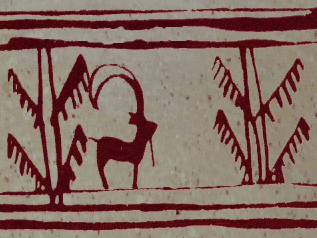|
World's
Oldest Animation
Burnt
City's Ancient Animation on Display



The
first world animated painting belonging to 5000 years ago along with
150 historical relics will be put on display from 28th of May in an
exhibition under the title of 10,000 years Persian Culture and Civilization.
This animation depicted a goat on an earthenware barrel in a position
of jumping towards a bush to eat it. This animated painting was discovered
in Burnt City in Sistan va Baluchestan province, southeastern Iran.
Mentioning that it would be the first time the animated goblet of Burnt
City is ever to go on display, Mohammad Reza Kargar, director of Iran's
National Museum said: In an attempt to choose a number of most unique
historical objects which have never been displayed before, the earthenware
animated goblet of the Burnt City has also been selected to put for
public display in this exhibition.
During their excavations in Burnt City in 1983, Italian archaeologists
found a 5000- year-old goblet in a grave with the design of a goat and
a tree. Further studies by archaeologists on this goblet revealed that
there is a unique characteristic about this discovered goblet. What
has made this one distinguished compared to the other ones unearthed
so far is that the painting on this goblet has been repeated in a meaningful
manner which shows the movement of a goat towards a bush during different
positions. The artist who created this design used the goblet as his
canvass to show the movement of the goat towards the tree for feeding
itself in 5 movements.
Images of goat and fish are the most prominent designs works on earthenware
dishes which have been unearthed so far in Burnt City which was one
of the most civilized and developed civilization during ancient times.
This painting shows the movement of images in the shortest time on a
goblet with an 8- centimetre mouth. On some other earthenware dishes
which have been unearthed in Burnt City, a number of repeated images
can be seen which do not move. From archaeologists point of view, people
who lived in this city during ancient times were very clever, artist
and well developed. This 10-centimetre goblet was placed on the top
of a pillar and was used for drinking.
Kargar further explained that in addition to this animation and the
most ancient banner of Iran discovered in Shahdad, a number of other
unique historical relics ranging in date from the 7th millennium BCE
to the Qajar dynastic era (1787-1921) will go on public display for
the first time. Some of these objects might have been probably go on
display for a while when they were discovered, however since they were
displayed for a very short period of time, a very few number of people
had the chance to see them. Regarding to the fact that this exhibition
will be held before the renovation of Iran Ancient Museum, we have tried
to select a collection of unique artifacts in the exhibition.
The exhibition of 10,000 years Persian Art and Civilization was due
to be held on February 2007, however, since the catalogue of the exhibition
was not ready and since the appropriate condition for holding the exhibition
was not prepared, the exhibition has been postponed until now.
This exhibition will be officially inaugurated tomorrow in the second
floor of Iran's National Museum with the presence of Esfaniar Rahim
Mashayi, president of ICHTO and a number of cultural heritage experts
and authorities.
|
